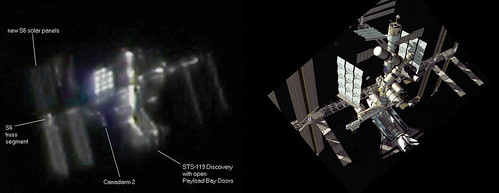In honor of the Shuttle Discovery undocking from the ISS today (scheduled for 15:53 Eastern time), I present to you Ralf Vandebergh, who is a very skilled astrophotographer. How skilled? Yeah, this skilled:
That shot, taken on March 20, shows the Space Shuttle Discovery docked with the International Space Station… taken from the ground. Vandebergh used a 25 cm telescope with a video camera to get this shot; he tracked the telescope by hand using an ordinary finder ‘scope mounted on the side.
Although the image is fuzzy – the placement of the Shuttle and ISS in the sky wasn’t optimal – the detail is incredible. I found a diagram on the NASA site with a drawing of the Shuttle docked to the ISS. Though it’s not perfect, the angles approximate what Vandebergh got, and you can identify structures:
 |
| Click to embiggen. |
Pretty cool, eh? You can see the back end of Discovery poking out from under the station (the payload bay doors are open), as well as ISS solar panels and other features, too.
At first glance getting a shot this clear might seem impossible, but in fact the math backs it up. The ISS orbits at 350 km over the surface of the Earth. Let’s say it’s straight overhead, so it’s as close (and therefore as big) as it can get. The wingspan of the ISS is a little over 100 yards. Doing the math*, I get that the station would be about 1 arcminute in size, or about 1/60th of a degree (for comparison, the Moon is 0.5 degrees across). That’s interesting; the resolution of the human eye is about an arcminute! So when it’s directly overhead, people with keen eyesight will just be able to see the station is not just a dot, but has an actual shape.
I didn’t know that. Wow. Through binoculars it’ll be very cool to see. I’ll have to try that.
Anyway, through a decent telescope – and Vandebergh’s 25 cm Newtonian is definitely a good sized ‘scope – you can actually get a good shot of the station. Usually, though, atmospheric turbulence blurs out the picture (which is also why stars twinkle). The trick is to use a video camera: that takes many frames rapidly, hopefully cutting down on the blurring in the same way that a fast exposure of a race car is sharp, while a longer one is blurry.
In fact, you can do even better. The blurring changes not only in time but in space as well. So in a given frame, the starboard solar panels might be sharp, but the port panels blurred. You can take multiple frames from the video and stitch them together, taking only the best parts and deleting the worst. I’ve seen some incredibly detailed images of the Shuttle and ISS taken from the ground; try a Google search and you’ll see plenty.
In fact, astrophotographer Vincent Miu shot this same ISS+Shuttle configuration just this week as well, and last year, the ISS was caught passing Venus in the sky during the day. I imagine anyone with a good ‘scope and a video camera mounted to it can get this sort of thing. That seems incredible to me, but such is they way astronomy has been transformed in the modern era.
Don’t forget, you can see the ISS easily with the naked eye (it can now get brighter than Venus, thanks to the new solar panels). Check out Heavens Above to see when it’s overhead! As soon as it clears up here in Boulder I’ll be out with my own binocs. I trust the math, but it always helps to verify.
* The apparent size of an object depends on how big and how far away it is. The formula is angle = constant x d/D, where d = size, D = distance, and the constant is 206,265 (which is arcseconds per radian, if you’re curious, to convert from natural units to arcseconds). 100 meters/ 350,000 meters x 206265 = about 60 arcseconds.
Tip o’ the spacesuit helmet to Dianne Speakman for the Miu shot.
Image of Station and Shuttle from the ground courtesy Ralf Vandebergh and ALPO, drawing of Shuttle and Station from NASA